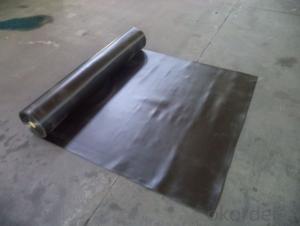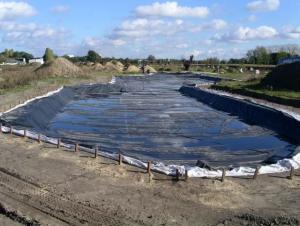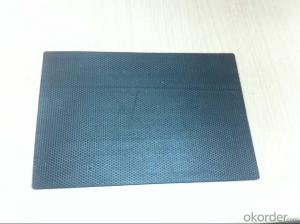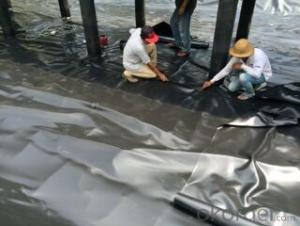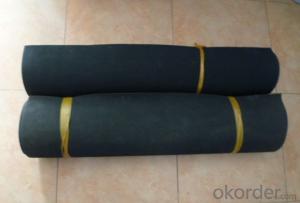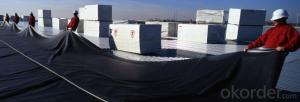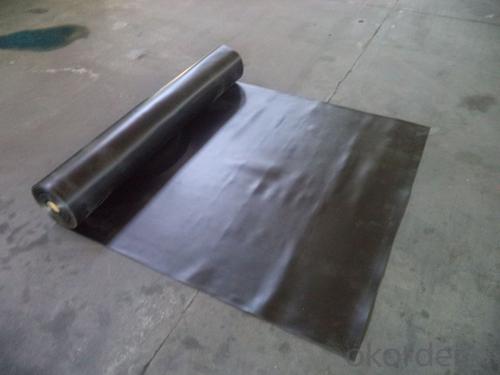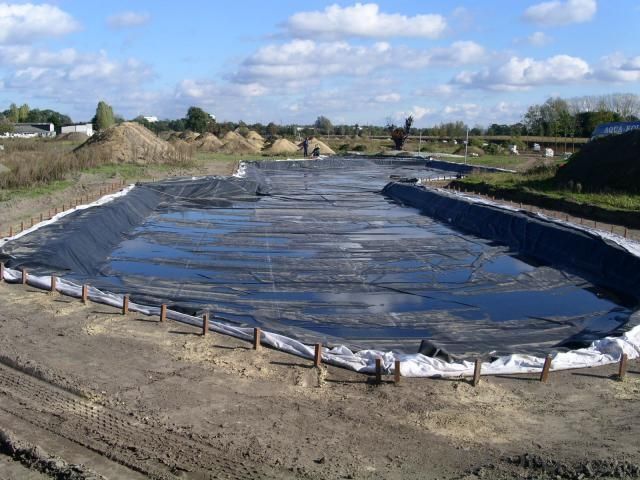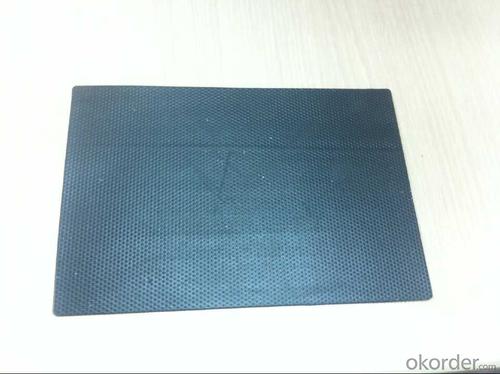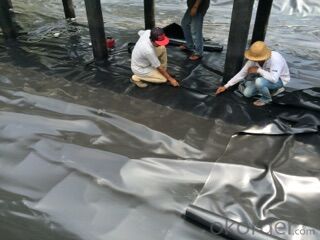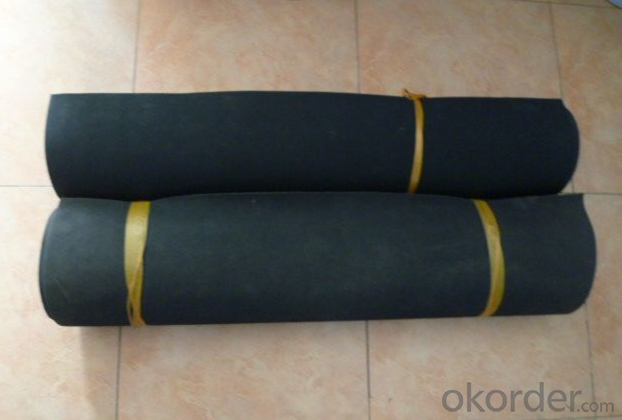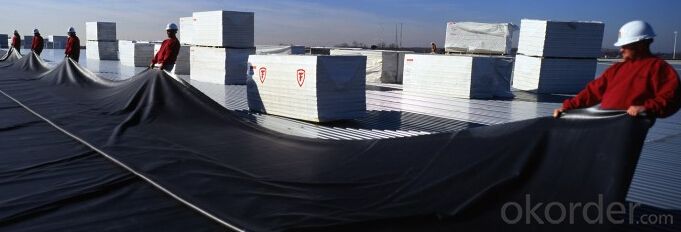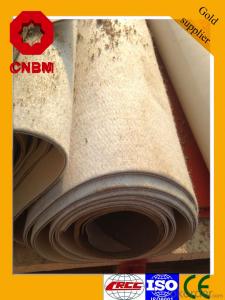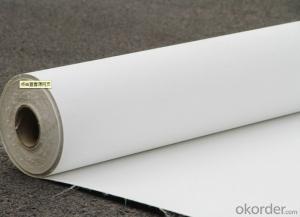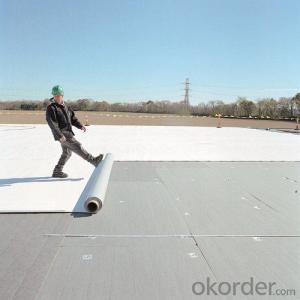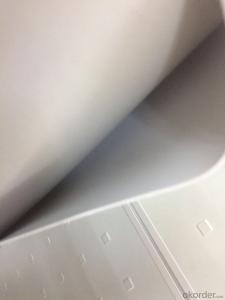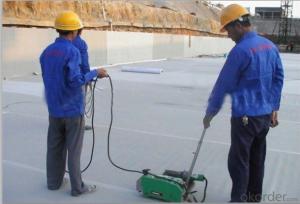PVC Waterproof Membrane Manufacturer with ISO
- Loading Port:
- Qingdao
- Payment Terms:
- TT OR LC
- Min Order Qty:
- 1000 m²
- Supply Capability:
- 100000 m²/month
OKorder Service Pledge
OKorder Financial Service
You Might Also Like
1. Introduction
Polyvinyl Chloride (PVC) waterproof membrane is a new polymer waterproof membrane which is made from polyvinyl chloride resin, and mixed with plasticizer, filler, anti-oxygen, ultraviolet absorber and other auxiliaries.
2. Features
l Excellent aging resistance.
l Root resistant penetration, specially used on planting roof.
l Welding installation. Joints are solid and environment friendly, no pollution.
l High tensile strength, good elongation and dimensional stability.
3. Specification
Length | 20m/roll or customized |
Width | 2.05m |
Thickness | 1.2mm; 1.5mm; 2.0mm |
If exposed | Exposed, Non-exposed |
Type | Homogeneous, Reinforced with fabric backing |
Color | White/Grey or customized |
4. Application
l All kinds of roofs, such as steel structure roof, planted roof etc.
l Underground engineering, such as building basement, subways, tunnels, air raid shelter, etc.
l Other projects like artificial lake, dam, water reservoir, grain storehouse, etc.
5. Technical Data Sheet
PVC Waterproof Membrane | Standard: GB12952-2011 | ||||||
NO. | Item | Unit | Value | ||||
H | L | P | |||||
1 | Resin Thickness on Middle Mesh ≥ | mm | - | - | 0.4 | ||
2 | Tensile Properties | Max. Strength ≥ | N/cm | - | 120 | 250 | |
Tensile Strength ≥ | Mpa | 10.0 | - | - | |||
Elongation at Max. Strength ≥ | % | - | - | 15 | |||
% | 200 | 150 | - | ||||
3 | Dimensional Stability after Heat Treatment ≤ | % | 2.0 | 1.0 | 0.5 | ||
4 | Foldability at Low Temperature | -25℃ No cracks | |||||
5 | Watertightness | 0.3Mpa, 2h No penetration | |||||
6 | Resistance to Impact | 0.5kg*m, No penetration | |||||
7 | Resistance to Static Loading* | - | - | 20kgs No penetration | |||
8 | Joint Peel Strength≥ | N/mm | 4.0 or membrane broken | 3.0 | |||
9 | Right Angle Tearing Strength≥ | N/mm | 50 | - | - | ||
10 | Trapezoid Tearing Strength≥ | N | - | 150 | 250 | ||
11 | Water Absorption (70℃, 168h) | After immersing≤ | % | 4.0 | |||
After drying≥ | % | -0.40 | |||||
12 | Aging in Hot Weather (80℃) | Time | 672h | ||||
Appearance | No bubbles, cracks, layering, sticky, holes | ||||||
Max. Tensile Retention Rate ≥ | % | - | 85 | 85 | |||
Tensile Strength Retention Rate ≥ | % | 85 | - | - | |||
Elongation Retention Rate at Max. Tensile ≥ | % | - | - | 80 | |||
Breaking elongation Retention rate≥ | % | 80 | 80 | - | |||
Low Temperature Flexibility | -20℃ No cracks | ||||||
13 | Chemical resistance
| Appearance | No bubbles, cracks, layering, sticky, holes | ||||
Max. Tensile Retention Rate ≥ | % | - | 85 | 85 | |||
Tensile Strength Retention Rate ≥ | % | 85 | - | - | |||
Elongation Retention Rate at Max. Tensile ≥ | % | - | - | 80 | |||
Breaking elongation Retention rate | % | 80 | 80 | - | |||
Low Temperature Flexibility | -20℃ No cracks | ||||||
14 | Artificial aging* | Time | 1500h* | ||||
Appearance | No bubbles, cracks, layering, sticky, holes | ||||||
Max. Tensile Retention Rate ≥ | % | - | 85 | 85 | |||
Tensile Strength Retention Rate ≥ | % | 85 | - | - | |||
Elongation Retention Rate at Max. Tensile ≥ | % | - | - | 80 | |||
Breaking elongation Retention rate | % | 80 | 80 | - | |||
Low Temperature Flexibility | -20℃ No cracks | ||||||
Remarks: *Resistance to static load is for PVC membranes used on roofing *The time of artificial aging of single-ply roofing membrane is 2500h. *Non-exposed membrane does not require determination of artificial aging. | |||||||
Welcome to discuss cooperation!
6. Image for EPDM Waterproof Membrane
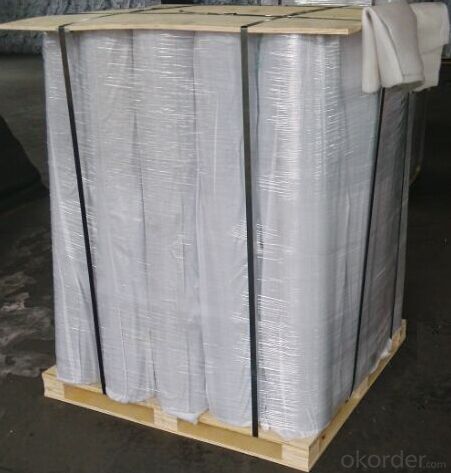
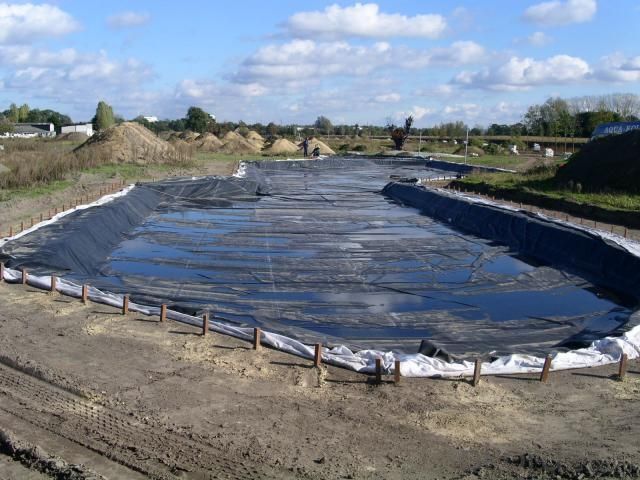
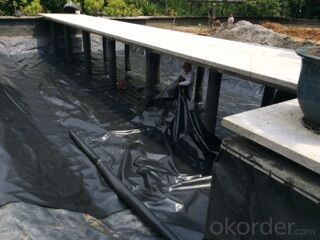

- Q: Can a waterproofing membrane be installed over existing coatings or sealants?
- Yes, a waterproofing membrane can be installed over existing coatings or sealants. However, it is important to assess the condition and compatibility of the existing coatings or sealants before installation to ensure proper adhesion and long-term performance of the waterproofing system.
- Q: Does a waterproofing membrane require a topcoat or sealer?
- In order to provide extra protection and enhance its effectiveness, a topcoat or sealer is typically required for a waterproofing membrane. The membrane itself is meant to prevent water from penetrating, but applying a topcoat or sealer can further strengthen its ability to repel water and prolong its lifespan. The topcoat or sealer functions as an additional layer of defense against moisture, UV rays, and other potential causes of damage. Moreover, it can help seal any minor cracks or imperfections in the membrane, ensuring a tighter seal and reducing the risk of water infiltration. Therefore, while a waterproofing membrane can offer some level of protection independently, it is generally recommended to add a topcoat or sealer for optimal performance and longevity.
- Q: Can a waterproofing membrane be used on tunnels with soundproofing systems?
- Tunnels with soundproofing systems can benefit from the use of a waterproofing membrane. It is common practice to integrate waterproofing membranes with soundproofing systems in tunnels. This is because tunnels are prone to water infiltration, which can cause structural damage and impact the performance of the soundproofing system. By applying a waterproofing membrane, the tunnel can be shielded from water intrusion, ensuring the durability and efficacy of the soundproofing system. Moreover, the waterproofing membrane aids in maintaining a dry and comfortable environment in the tunnel, which is essential for the efficient operation of the soundproofing system. Therefore, combining a waterproofing membrane with a soundproofing system is highly recommended in tunnels to provide both water protection and sound insulation.
- Q: Can a waterproofing membrane be used on metal surfaces?
- Yes, a waterproofing membrane can be used on metal surfaces. Waterproofing membranes are versatile and can adhere to various materials, including metal. They provide effective protection against water damage and can be applied to roofs, walls, and other metal surfaces to prevent leaks and corrosion.
- Q: Does a waterproofing membrane require any specific surface preparation?
- Yes, a waterproofing membrane does require specific surface preparation before installation. The success and effectiveness of the membrane largely depend on the quality and condition of the surface it is applied to. Firstly, the surface needs to be clean and free from any dirt, debris, oil, grease, or loose particles. This can be achieved by thoroughly cleaning the surface using a pressure washer, scrub brush, or appropriate cleaning agents. Any existing coatings or sealants should also be removed to ensure proper adhesion of the membrane. Secondly, the surface should be smooth and even. Any uneven areas, cracks, or holes should be repaired and leveled before applying the membrane. This can be done by filling the cracks or holes with a suitable filler or patching compound and smoothing it out to create a uniform surface. Thirdly, the surface should be dry. Moisture can compromise the adhesion and effectiveness of the waterproofing membrane. Therefore, it is important to ensure that the surface is completely dry before starting the installation. This may require allowing the surface to air dry or using appropriate drying methods such as fans or dehumidifiers. In addition to these general surface preparations, specific types of waterproofing membranes may have additional requirements. For example, some membranes may require a primer to be applied on the surface before installation. It is essential to follow the manufacturer's instructions and recommendations for the specific membrane being used. Overall, proper surface preparation is crucial for the success of a waterproofing membrane installation. It ensures optimal adhesion, durability, and performance of the membrane, ultimately preventing water penetration and protecting the underlying structure.
- Q: Can a waterproofing membrane be used for underground parking structures?
- Yes, a waterproofing membrane can be used for underground parking structures. Waterproofing membranes are commonly used in construction to prevent water infiltration and protect the structure from moisture damage. In underground parking structures, where there is a higher risk of water seepage due to the location below ground level, a waterproofing membrane can be applied to the walls, floors, and ceilings to create a barrier against water intrusion and ensure the longevity and integrity of the structure.
- Q: Can a waterproofing membrane be used for swimming pool decks and patios?
- Yes, a waterproofing membrane can be used for swimming pool decks and patios. A waterproofing membrane is designed to prevent water penetration and protect the underlying structure from water damage. Swimming pool decks and patios are constantly exposed to water, whether through splashing or rain, making them susceptible to water damage. By applying a waterproofing membrane, you can ensure that the pool deck or patio remains protected and free from water-related issues such as cracking, mold, or deterioration. This membrane acts as a barrier, preventing water from seeping into the concrete or other materials, thus extending the lifespan of the pool deck or patio. It is essential to choose a high-quality and suitable waterproofing membrane specifically designed for outdoor use to ensure optimal performance and durability.
- Q: What materials are commonly used for waterproofing membranes?
- Different materials are commonly used for waterproofing membranes, each having their own unique properties and advantages. Some of the most frequently used materials are as follows: 1. Bitumen: Due to its exceptional waterproofing properties, bitumen is a popular option for waterproofing membranes. It is a sticky, black, and viscous substance derived from petroleum. Often, it is blended with polymers to increase its flexibility, durability, and resistance to UV radiation. 2. PVC (Polyvinyl Chloride): PVC membranes are extremely durable and resistant to chemicals, making them suitable for a variety of waterproofing applications. They are easy to install and can withstand extreme temperatures, making them a preferred choice for flat roofs and underground structures. 3. EPDM (Ethylene Propylene Diene Monomer): EPDM is a synthetic rubber membrane that is highly flexible and durable. It can withstand UV radiation, ozone, and extreme temperatures, making it suitable for both above and below-ground applications. EPDM membranes are commonly used for roofs, foundations, and pond liners. 4. TPO (Thermoplastic Olefin): TPO membranes are a combination of rubber and plastic polymers, making them highly flexible, durable, and resistant to UV radiation. They are lightweight and easy to install, making them popular for commercial roofing applications. 5. HDPE (High-Density Polyethylene): HDPE membranes are manufactured from high-density polyethylene and are known for their excellent resistance to chemicals. They are commonly employed for waterproofing underground structures, such as tunnels and basements. 6. Bentonite: Bentonite clay is a natural material that expands when it comes into contact with water, creating a gel-like substance that seals cracks and pores. Bentonite membranes are frequently utilized for waterproofing below-ground structures and are highly effective in preventing water infiltration. 7. Liquid applied membranes: These membranes are typically composed of a combination of synthetic polymers and rubber. They are applied as a liquid and, once cured, form a continuous, seamless, and flexible waterproofing layer. Liquid applied membranes are versatile and can be used for various applications, including roofs, balconies, and foundations. It is important to note that the choice of material depends on the specific requirements of the project, including the type of structure, environmental conditions, and budget. Consulting with a waterproofing professional is recommended to determine the most suitable material for a particular application.
- Q: About asphalt waterproofing membrane
- 4, SBS membrane is commonly referred to as a polymer modified asphalt coil, there are other APP, APAO and other modified asphalt membrane.
- Q: Can waterproofing membranes be applied on roofs?
- Roofs can have waterproofing membranes applied to them, a practice commonly employed in the construction industry to add an extra layer of protection against water infiltration. These membranes, typically composed of synthetic materials like PVC, TPO, or EPDM, possess high resistance to water and effectively prevent leaks and water damage on roofs. Applying waterproofing membranes on roofs is a proven method for enhancing the longevity and durability of the roofing system, particularly in areas prone to heavy rainfall or extreme weather conditions. Moreover, waterproofing membranes are flexible and can be easily installed on various roofing materials such as concrete, metal, or asphalt shingles. Consequently, if you desire a watertight roof and wish to safeguard your property from water-related problems, the utilization of waterproofing membranes offers a dependable and efficient solution.
Send your message to us
PVC Waterproof Membrane Manufacturer with ISO
- Loading Port:
- Qingdao
- Payment Terms:
- TT OR LC
- Min Order Qty:
- 1000 m²
- Supply Capability:
- 100000 m²/month
OKorder Service Pledge
OKorder Financial Service
Similar products
Hot products
Hot Searches
Related keywords
